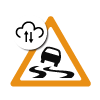Through an internet connection, your vehicle and other vehicles on the same road can share information about accidents, slippery road conditions and other situations that may cause the hazard warning lights to activate.
Connected safety can be enabled or disabled in privacy settings.
Warning
Never rely on the vehicle's connected safety warnings as a replacement for safe driving practices. Drive with the same attention to safety that you would need in a vehicle without this feature.
Connected safety warnings
Depending on the nature of the information your vehicle receives from other road users, one of these two symbols may be shown in the instrument panel:
 | A vehicle's hazard warning lights have been activated further up the road. |
 | Slippery road conditions are detected further up the road. |
Tip
Warnings from connected safety can also be shown in the head-up display.
Conditions and limitations
Connected safety relies on communication between your vehicle and other vehicles on the road. This communication relies on a number of conditions, such as:
- The connected safety feature must be enabled in settings.
- Connected safety must be available to the other road users.
- The vehicles involved must be connected to the internet. If the internet connection is weak or unavailable, the feature is disabled until the connection improves.
- The road you're on is in the Volvo Cars database.
Note
A slippery road may not always result in a warning from connected safety, as your vehicle or other connected road users may not experience problems with slippage despite these conditions. Low-friction situations between the tires and road surface are often used as markers to identify slippery roads. Low-traction maneuvers, such as slight steering, braking or acceleration, rarely cause low-friction situations. Therefore, it might prove difficult to identify the road as slippery during such maneuvers.